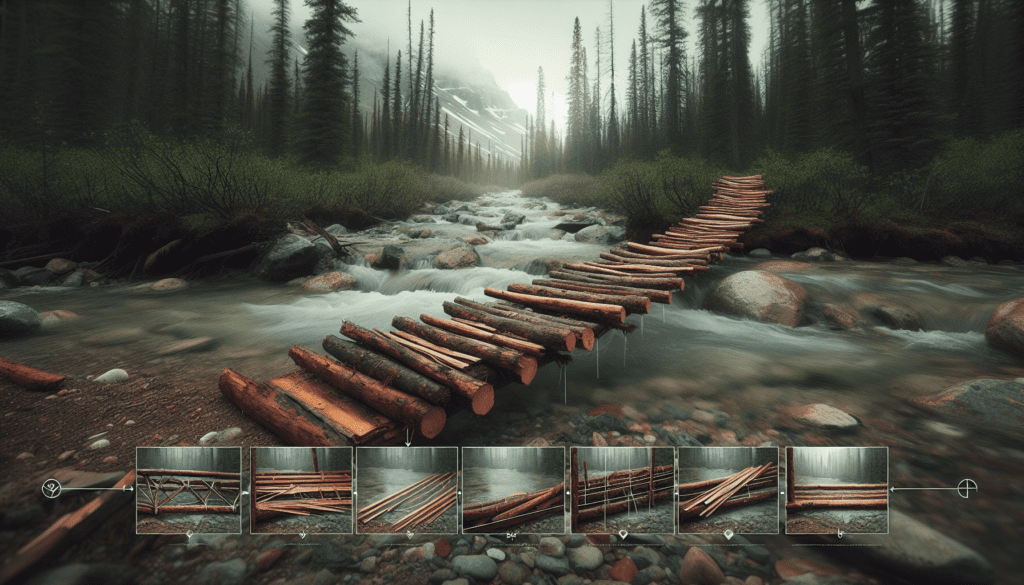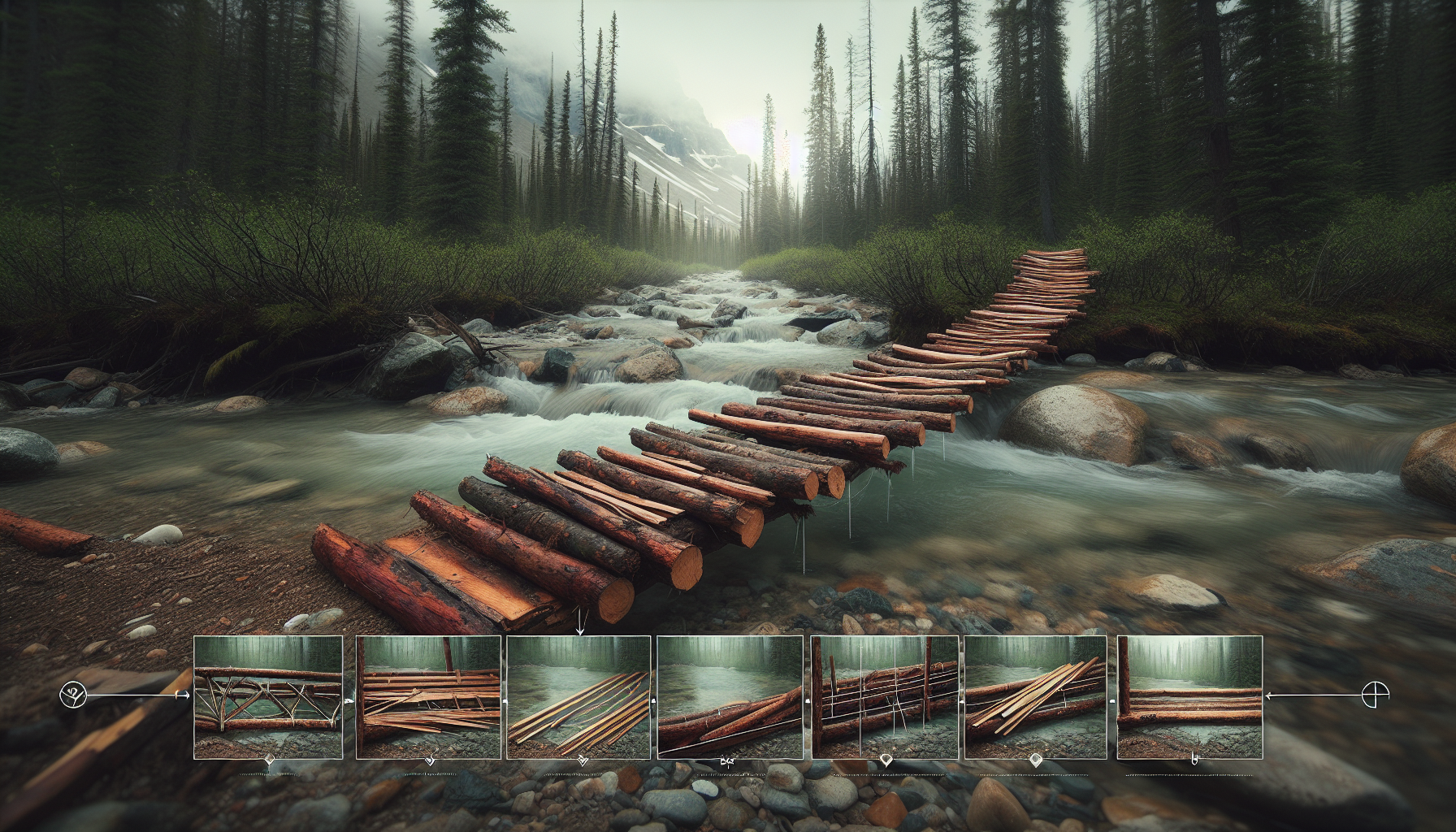Imagine standing at the edge of a vast wilderness, eager to explore the untouched beauty that lies beyond. The only thing standing between you and the adventure of a lifetime is a river that seems impossible to cross. But fear not, for in this article, you will learn the art of building a simple bridge that will pave the way for your wilderness exploration. With just a few materials and a handy set of instructions, you will be able to construct a sturdy and reliable bridge that will withstand the test of time. So grab your tools and let’s get started on this exciting journey of bridge building!

Materials Needed
To build a simple bridge in the wilderness, you will need several materials. First and foremost, you will need wooden planks that will act as the main structure of the bridge. These planks should be sturdy and long enough to span the desired distance. Additionally, you will need rope or cables to secure the planks together and provide support. Metal brackets will also be necessary to reinforce the bridge and ensure its stability. Lastly, don’t forget to gather nails, screws, and a set of essential tools like a saw, hammer, and drill to aid in the construction process.
Choosing the Right Location
Choosing the right location for your bridge is crucial to its success and longevity. Start by assessing the terrain to ensure it is suitable for building a bridge. Look for a location with a relatively level surface and minimal obstacles that could hinder construction or impede access.
Identifying a water source and path is also essential. Determine the direction and flow of the water to understand how it will interact with the bridge. Building the bridge perpendicular to the water flow will help minimize erosion and increase stability.
When selecting a location, it is important to consider the environmental impact of your construction. Avoid sensitive ecosystems or areas prone to floods that could jeopardize the bridge’s integrity. By carefully assessing the terrain, water source, and environmental factors, you can ensure a successful bridge construction.
Planning the Bridge Design
Before diving into the construction process, it is essential to plan the design of your bridge. Start by determining the length and width of the bridge based on the distance it needs to cover and the expected foot traffic.
Next, you should decide on the type of bridge you want to build. Common options include beam bridges, which are simple and cost-effective, or suspension bridges, which are ideal for longer spans. Consider the available materials and your construction expertise when making this decision.
Calculating the load capacity of your bridge is another critical aspect of the planning process. You must ensure that it can safely support the anticipated weight of people, animals, or vehicles that will cross it. Consulting with an engineering professional or using load capacity calculation tools can help determine the necessary bridge strength.
Preparing the Construction Site
Once you have chosen the right location and finalized your bridge design, it’s time to prepare the construction site. Start by clearing away any vegetation or debris that may hinder the construction process. It is important to have a clean and spacious area to work in.
Creating a level foundation is crucial to ensuring the stability and longevity of the bridge. Remove any bumps or uneven surfaces, and make sure the ground is as flat as possible. This will provide a solid base for your bridge and prevent any future shifting or sinking.
Proper drainage is also essential for the overall stability of the bridge. Ensure that water can flow freely underneath the bridge by creating channels or installing drainage pipes if necessary. Preventing water buildup will prevent erosion and damage to the bridge’s foundation.

Constructing the Bridge Foundation
The bridge foundation is the structural base that supports the entire bridge. Start by digging support holes in the ground at regular intervals, depending on the length of your bridge. These holes should be deep enough to provide a stable foundation, considering the soil type and anticipated load capacity.
If your site requires additional stability, consider creating concrete footings for the bridge foundation. These footings will offer extra support and help distribute the weight more evenly. Consult with an engineer if you are unsure whether concrete footings are necessary for your bridge.
Once the support holes or footings are in place, it’s time to set up the wooden posts. Carefully secure each post in its respective hole or footing, ensuring it is vertical and well-aligned. Use ropes, cables, or temporary braces to hold the posts in place until the bridge construction is complete.
Building the Bridge Deck
The bridge deck is the surface that pedestrians or vehicles will walk or drive on. To construct the bridge deck, start by attaching the wooden beams or planks across the installed supports. Carefully measure and cut the beams to the appropriate length, ensuring they extend from one support to another.
Once the beams are in place, secure them to the supports using nails or screws. Make sure to use enough fasteners to ensure a strong connection. It is essential to space the screws or nails evenly to distribute the load across the beams and prevent any weak spots.
Throughout this process, continuously check that the deck is properly aligned. Adjust the position of the beams or planks as needed to create a smooth and even surface, providing a safe crossing for pedestrians or vehicles.
Adding Support Structures
Adding support structures to your bridge will provide added stability and reinforcement. Install additional beams or braces underneath the bridge deck, perpendicular to the existing supports. These structures will help distribute the weight more evenly and prevent sagging or structural failures.
Use metal brackets for reinforcement, securing them to the beams or braces and the supports. These brackets will provide an extra level of support, particularly in areas that experience heavy foot traffic or vehicle usage. Ensure that the brackets are properly aligned and firmly attached to maintain the bridge’s stability.
Throughout the process, prioritize stability and weight distribution to ensure a safe and durable bridge structure. Taking the time to add support structures is crucial for a successful and reliable bridge construction.
Constructing Railings or Handrails
To enhance safety, it is important to construct railings or handrails on your bridge. Choose appropriate materials that are durable and weather-resistant. Common options include wood, metal, or plastic, depending on your preference and available resources.
Secure the railings to the bridge deck, ensuring they are firmly attached and capable of withstanding pressure. It is important to choose an appropriate height for the railings to prevent falls and accidents. Consult local safety regulations or guidelines to determine the recommended height for your specific bridge.
Regularly inspect and maintain the railings to ensure they remain secure and in good condition. Making safety a priority throughout the construction process will result in a bridge that can be enjoyed with peace of mind.
Testing and Inspecting the Bridge
Once the construction is complete, it is essential to thoroughly test and inspect the bridge before allowing regular use. Test the stability and weight-bearing capacity of the bridge by gradually increasing the load and checking for any signs of strain or weakness.
Inspect the entire structure for any structural issues, such as loose fasteners, cracks, or signs of shifting. Address any problems immediately to prevent further damage or compromise the bridge’s integrity.
Conduct trial crossings to ensure the bridge is safe and functional. Test the bridge with pedestrians or vehicles that represent the expected usage. Pay attention to any vibration or unusual movement and address those concerns promptly.
Maintaining and Repairing the Bridge
Regular maintenance and repair are critical for the longevity and safety of your bridge. Schedule regular inspections to check for any damage or wear. Remove any debris that may accumulate on the bridge and clean it thoroughly to prevent slippage or deterioration.
Replace any damaged or worn-out components promptly. This includes loose fasteners, cracked beams, or rotted planks. Regularly check the stability of the foundation and address any signs of erosion or shifting.
Addressing erosion or other environmental factors is also crucial for maintaining the bridge’s integrity. Install erosion-resistant measures, such as rocks or concrete blocks, to protect the foundation and prevent water damage.
By prioritizing regular maintenance and promptly addressing any issues, you can extend the lifespan of your bridge and ensure a safe crossing for years to come.
Building a simple bridge in the wilderness may seem like a daunting task, but with careful planning, the right materials, and proper construction techniques, it can be a rewarding project. Remember to prioritize safety, stability, and environmental considerations throughout the process. By following the outlined steps and paying attention to detail, you can create a functional and durable bridge that blends harmoniously with the surrounding wilderness.

